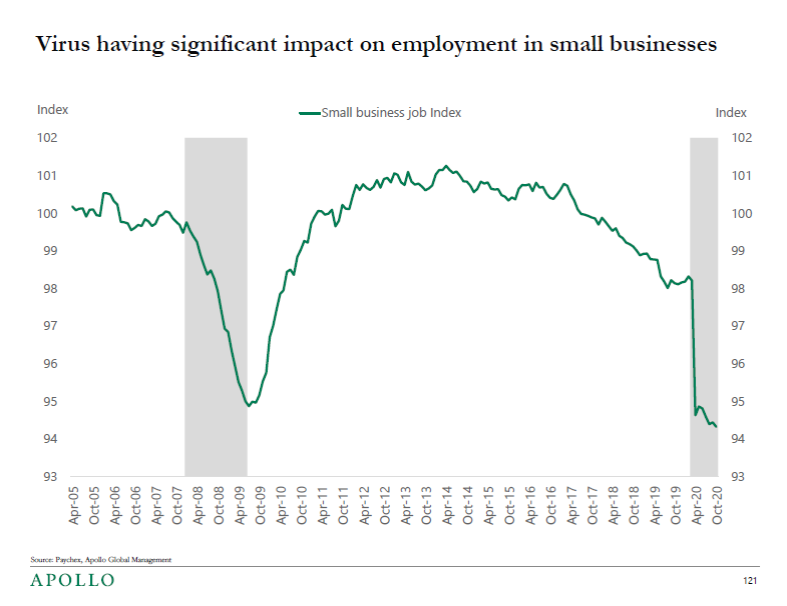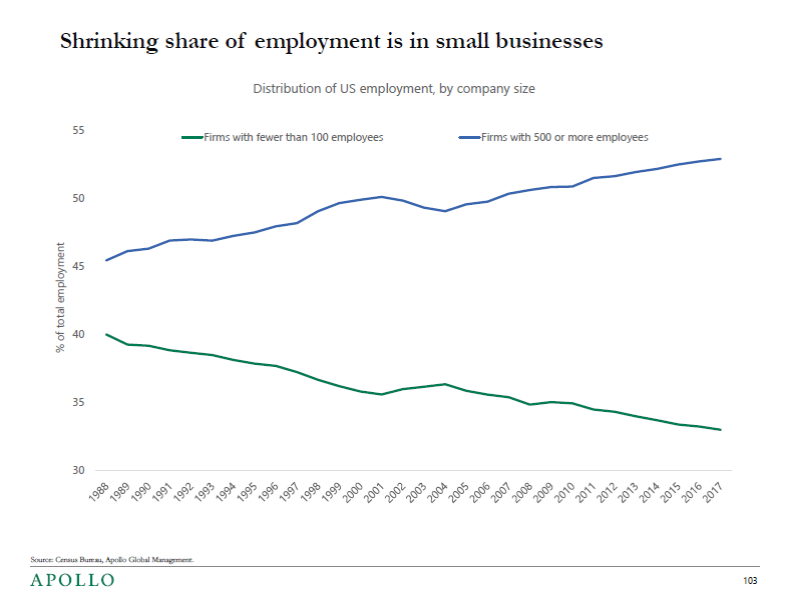Simple chart shows how much small business continues to struggle

The election results may appear to be good for markets, but coronavirus cases have crossed the 100,000-cases-per-day mark and are taking a major toll on small businesses.
In a note from Torsten Sløk of Apollo Global Management, Sløk pointed out that the virus is preventing key behavior that benefits small business — especially people going to restaurants, bars, cafés and more.
"This continues to weigh on employment numbers for small businesses," he wrote.
The small business index plummeted in March, but it has continued a downward trajectory since recovering slightly in the summer as the virus ebbed somewhat and outdoor infrastructure was established in the warmer months.
“Given half of U.S. employment is in businesses with less than 500 workers and given the lower likelihood of additional fiscal support, this is a downside risk to nonfarm payrolls over the coming months, including tomorrow,” Sløk wrote. The Bureau of Labor Statistics will release the October employment report on Friday, Nov. 6.

This matched trends in ADP data that showed continued struggles for small businesses, which here are qualified as those with fewer than 500 workers.
Sløk writes that the crisis for these businesses will not be over until the coronavirus crisis is likewise over, and the earliest would be mid-2021.
The reason why this affects small businesses more than large ones, Sløk told Yahoo Finance, is because small businesses don’t really get much financing in corporate bond markets. Large businesses can do so, and the Fed’s activity has supported these markets considerably.
Small businesses, on the other hand, mainly get financing from banks — and banks have tightened their credit conditions, making it harder to get loans.

This has created a major divergence between small businesses and their larger counterparts. On the one hand, the corporate bond markets are strong. On the other, lending standards for banks are tight.
The U.S. Chamber of Commerce’s small business index has bounced back from a dismal Q2, it’s still behind confidence levels it had before the pandemic. The Chamber noted that small businesses saw the economy as their top voting issue in the recent election — consistent with many exit polls that said the economy was a greater issue than the coronavirus, even though Sløk and other economists see the two as one in the same. To wit, due to lowered economic and consumer activity due to coronavirus, which has cost over 234,000 lives, 60% of shuttered businesses will never reopen, according to Yelp.

At the same time, the National Federation of Independent Business announced this week that many small businesses were looking to hire but were having trouble finding qualified labor.
This is yet another instance of a so-called K-shaped recovery, where one group recovers much faster than the other. Just this week, Jefferies unveiled a new S&P 500 price target of 3,750 for 2021, showing a fairly bullish outlook for these 500 large American companies — especially given the likely election outcome.
-
Ethan Wolff-Mann is a writer at Yahoo Finance focusing on consumer issues, personal finance, retail, airlines, and more. Follow him on Twitter @ewolffmann.
